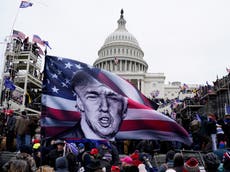What we know about the Capitol riots one month on
Who was behind the extraordinary storming of the United States legislature?
It is one month since hundreds of angry pro-Trump rioters stormed the US Capitol in an attempt to stop Congress from approving the presidential election results.
The violence killed five, including a police officer, and shook US politics to the core. One month later, here’s what we know about what led to the attacks, who stormed the Capitol, how they were able to get in, and what kinds of consequences—or the lack thereof—those involved have faced.
What led to the attacks?
The most obvious culprits are Donald Trump and his Republican allies in Congress. They insisted up until the moment the Capitol got stormed—and in many cases even afterwards—that the election was rigged and should’ve gone for Mr Trump, despite no real evidence, more than 60 unsuccessful court cases and Trump administration officials like then-attorney general Bill Barr saying the results were legitimate.
In a fiery speech hours before the attacks, Mr Trump urged his supporters to “show strength,” said “you are allowed to go by very different rules” in the case of fraud, and vowed “we will never give up,” before promising them they would all head “peacefully” to the Capitol together.
At that, he went on, “We’re going to cheer on our brave senators and congressmen and women, and we’re probably not going to be cheering so much for some of them. Because you’ll never take back our country with weakness.”
Numerous Republicans in both houses of Congress back the president’s spurious claims, and a majority of House Republicans voted to object to election results in swing states Arizona and Pennsylvania even after the attack on the Capitol.
More recent reporting from The Intercept has also shown that anti-mask and anti-coronavirus lockdown groups were fertile recruiting grounds for the Stop the Steal protestors who besieged the Capitol, while the FBI believes that some of the far-right Proud Boys streetfighters at the demonstrations wanted to attack the Capitol to get revenge on police, who they felt didn’t do enough about the stabbing of one of their members.
Who took part in the demonstrations?
In the conventional sense, the crowd wasn’t very diverse: it was mostly white people who stormed the Capitol. But aside from that, there was no one feature that defined the crowd, beside feverish loyalty to Donald Trump and membership in the big tent of right-wing anger. The mob allegedly included CEOs and business owners; hard-right militia members like the Oath Keepers, Three Percenters, and the Proud Boys; white supremacists; QAnon true-believers; at least 18 current and former law enforcement and military members, and others.
How were they able to get in and out of the Capitol?
Trump supporters had been planning for weeks to mob Washington, sometimes out in the open online, but the mob was quickly able to breach the Capitol. Despite the heroic efforts of individual officers like Eugene Goodman, who led attackers away from the Senate just moments before lawmakers escape, law enforcement authorities were vastly outnumbered and overwhelmed, and largely let the Capitol attackers leave without questioning or arrest.
Homeland Security officials had been warning for months that white supremacist extremists were “the most persistent and lethal threat in the homeland” , and Congress members like Maxine Waters of California warned Capitol police of the coming potential for violence, but poor prior planning and coordination between police and National Guard, who reportedly ignored requests for immediate help, left the Capitol sparsely defended compared to the threat.
Some members of Congress have also called for investigations into whether the rioters had inside help getting into the Capitol or knowing its weak spots, citing an abnormal number of visitors in the days before the attack. Two US Capitol police officers were suspended for their conduct during the insurrection, one for taking a selfie with demonstrators and another for putting on a Make America Great Again hat and giving people directions.
Others have argued that, owing to racism, the largely white crowd provoked a lax security response, compared to the mass mobilization of law enforcement and security personnel during Black Lives Matter protests, where thousands were arrested and many more hit with violent crowd control weapons like tear gas and batons.
Who has been punished?
More than 160 people are facing federal charges for their ties to the attacks, according to Department of Justice figures from Saturday, and top cabinet officials and security officials including the US Capitol police chief, the House and Senate sergeants-at-arms have resigned following the catastrophic security breach.
There’s also been intense political fallout, including the second impeachment of Donald Trump, corporations cutting donations to Republicans who challenged the election, and ethics complaints and calls for the resignations of senators Josh Hawley and Ted Cruz for their part in spearheading election objections.
What happens now?
It seems unlikely Mr Trump will be convicted during his impeachment trial in the Senate, as 45 Republican senators voted in late January on a resolution calling the process unconstitutional in these circumstances.
As for the rioters, authorities are looking into the degree to which the attack were pre-planned and considering using mob conspiracy statutes in their cases, both of which could heighten penalties.
Subscribe to Independent Premium to bookmark this article
Want to bookmark your favourite articles and stories to read or reference later? Start your Independent Premium subscription today.





Join our commenting forum
Join thought-provoking conversations, follow other Independent readers and see their replies
Comments